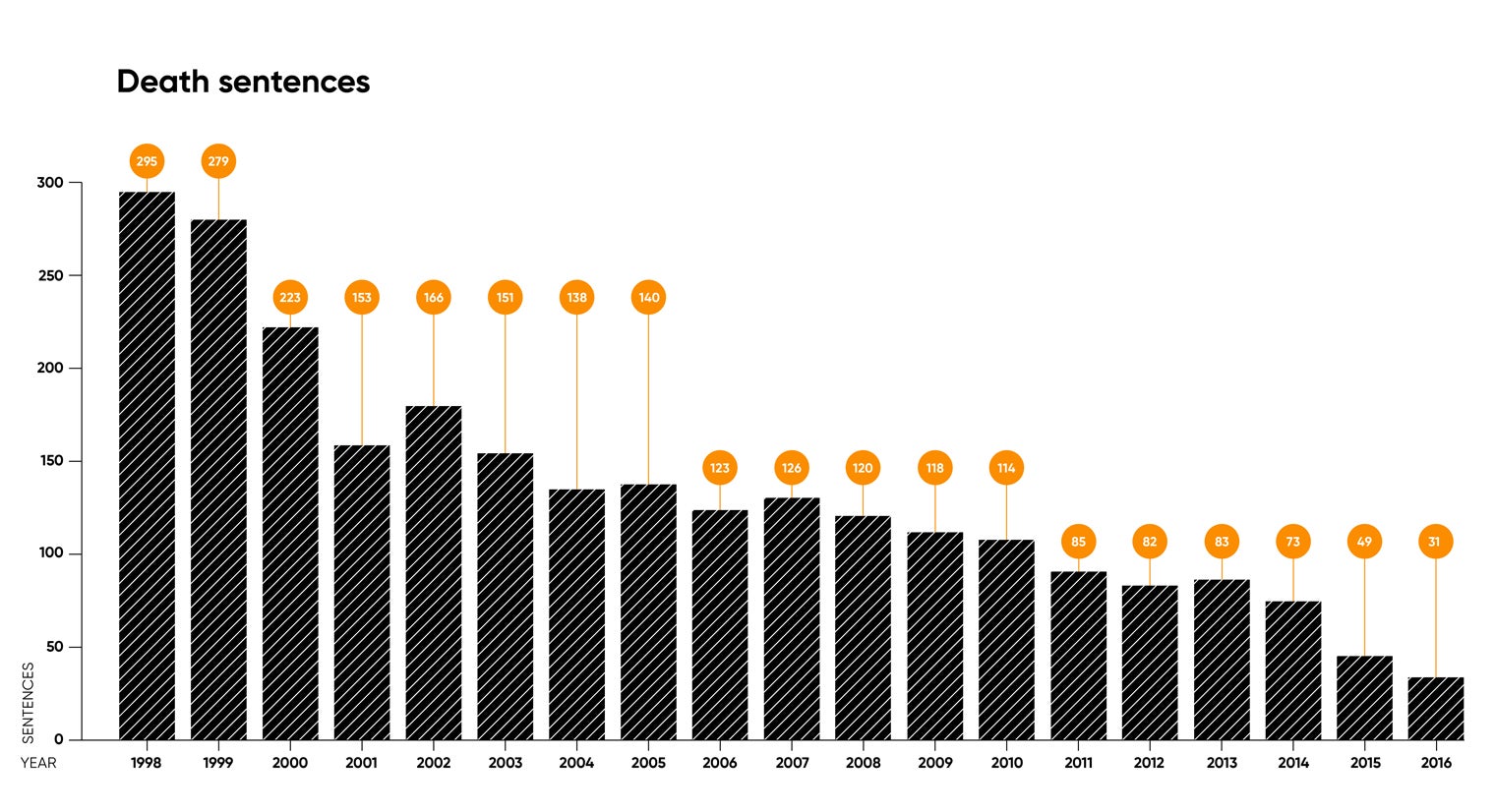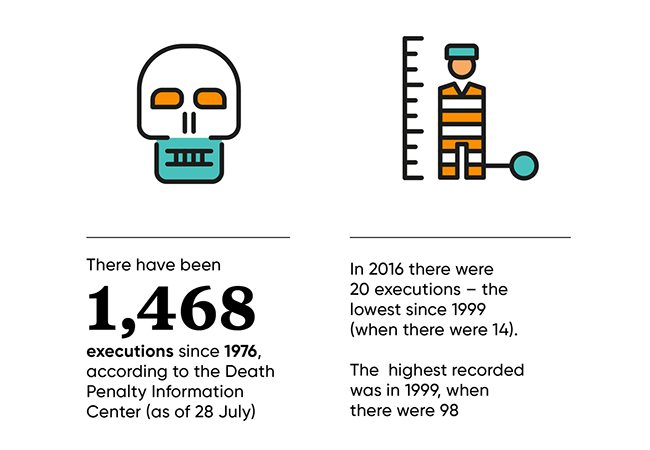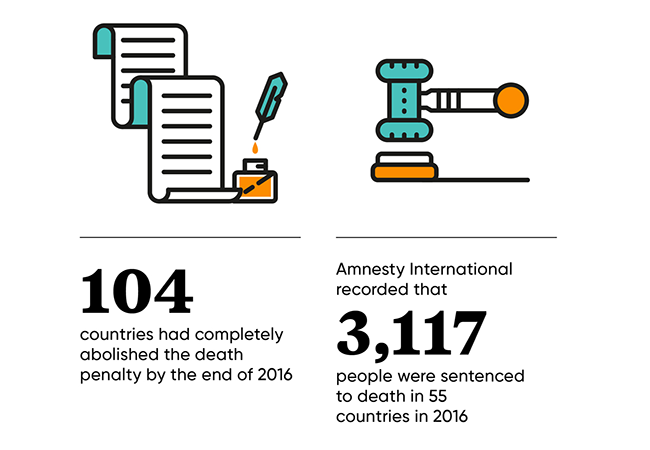“America is in the midst of a climate change on capital punishment,” according to Robert Dunham, executive director of the Death Penalty Information Center (DPIC). He would know; for two decades before taking his current position at the venerated, nonpartisan organisation, in March 2015, Dunham was a leading capital appellate lawyer in Pennsylvania. And statistics overwhelmingly back up his statement that arguments for capital punishment in the United States are dying out, slowly.
In 2016 there were just 20 executions and 31 new death sentences handed out, marking a record low since 1991 and 1973 respectively. “We are witnessing a significant decline in the use of the death penalty, and it’s a long-term decline,” says Dunham, suggesting that despite there being 2,902 people on death row, at the latest count (taken at the end of October 2016) the prevailing mood is that country-wide abolition is nearer than it has been for four decades.
“When you look at public opinion polls, support for the death penalty is also at a 40-year low,” he continues. “We’re seeing a historical movement away from the death penalty.”
Waning death sentence numbers sign of changing times
There have been 1,457 executions in America since 1973, the year after the Supreme Court declared the existing death penalty statutes were unconstitutional. With states hastily re-writing their capital punishment laws, the numbers crept up again to reach a high of 98 in 1999, but they have steadily fallen in the 21st century. In 2012, there were 43 executions, and the figure has continued to drop to 39 in 2013, 35 the next year, and 28 in 2015.
In an increasingly abolitionist world, it has become harder and harder for retentionist countries to justify their resort to this anachronistic punishment
While Dunham says the 2017 total is likely to increase from last year’s 20 – with 16 chalked up at the time of writing, and 11 more scheduled before the year is out (though some stays of execution and additional death warrants are likely) – the pattern is clear.
“Executions are a lagging indicator, and new death sentences are a leading indicator,” he continues. “The 31 new death sentences last year were the fewest imposed in the modern era of the United States Capital Punishment. Consider that in 1994 there were 316 death sentences imposed; that’s more than 10 times the amount of the 2016 figure, so there has been a significant reduction.”
At present 19 states have banned the death penalty in the USA, including six since 2007. It is retained in 31, though 11 of those – California, Colorado, Kansas, Montana, Nebraska, Nevada, New Hampshire, North Carolina, Oregon, Pennsylvania and Wyoming − have not carried out executions for at least a decade.

The number of US death sentences have been in decline since 1998
DNA testing counters arguments for capital punishment
There are numerous factors for the change in climate around the death penalty, and developments in deoxyribonucleic acid (DNA) testing, which became available in the late 1980s, is a key one. DPIC research highlights that 159 death row prisoners have been exonerated since 1973, and 20 of those have been thanks to fresh DNA evidence.
Falsely convicted rapist and murderer Nick Yarris, a former client of Dunham’s, was a beneficiary of scientific advancements in this field. He was freed in 2004 after 22 brutal years on death row, most of which was spent in solitary confinement, and now resides in Britain. “The majority of people given the evidence that was presented would think that it was an open-and-shut case against Nick,” recalls Dunham.
“He had the same blood type as the murderer, by unfortunate coincidence, and four separate eye witnesses claimed to have seen someone who matched his description at the shopping mall from where the victim was abducted. Objectively most juries would have convicted Nick.
“The DNA not only showed that Nick didn’t do it, it showed that all of this other evidence was wrong. And it’s that type of error that we see in case after case. DNA testing erodes confidence in the reliability of these other forms of evidence.”
How much does the death penalty cost?
That death penalty cost statistics are exorbitant is another reason it is losing support. Dunham states that on average the death penalty “costs the state $23 million (£17.5 million) per year more than a system of justice that does not have the death penalty, and in states like California the cost runs as high as $100 million (£76 million) more a year”.
Further, capital punishment does not discourage would-be murderers, seemingly. “There is, in fact, no evidence that the death penalty is a deterrent,” notes Dunham. “In actuality, murder rates are higher, on average, in the states that have the death penalty than in the states that do not have the death penalty.”

French philosopher Albert Camus wrote, in an 1957 essay entitled Reflections on the Guillotine: “For centuries the death penalty, often accompanied by barbarous refinements, has been trying to hold crime in check; yet crime persists. Why? Because the instincts that are warring in man are not, as the law claims, constant forces in a state of equilibrium.”
No evidence that capital punishment deters crime
Rob Freer, an American-based researcher for Amnesty International, agrees: “The deterrence argument for capital punishment has largely fallen out of favour in the US, leaving retribution or incapacitation as the main justifications.”
Freer points to the words spoken by Justice John Paul Stevens – then the then most senior US Supreme Court Justice – in 2008. “Despite 30 years of empirical research in the area, there remains no reliable statistical evidence that capital punishment deters potential offenders,” he said. “It is the retribution rationale that animates much of the remaining enthusiasm for the death penalty.”
Indeed, Justice Stevens referred to a study which found that 37 per cent of death penalty supporters in the USA cited “an eye for an eye” as their reason for backing capital punishment; another 13 per cent answered “they [the criminals] deserve it”.
“In Amnesty International’s opinion,” Freer continues, “the death penalty breaches two essential human rights: the right to life and the right to live free from torture. Both rights are protected under the Universal Declaration of Human Rights, adopted by the United Nations in 1948. No argument can render the death penalty compatible with basic human rights principles and human dignity. In an increasingly abolitionist world, it has become harder and harder for retentionist countries to justify their resort to this anachronistic punishment.”
The British lawyer fighting to ban the death penalty
That is certainly a view shared by Clive Stafford Smith, a British lawyer who has devoted his entire working life to fighting capital punishment and calls it “a total farce”. “I went to America when I was 18 to put an end to the death penalty, having become obsessed by it at school,” he says. After completing his law degree at New York’s Columbia University he became renowned for his doggedness and passion at capital trials. “I’ve represented over 300 prisoners in America, and we have avoided executions in 98 per cent of those cases,” he says.
Incredibly, Stafford Smith has taken cases to the US Supreme Court a handful of times, and won on all five occasions. In 1999 he founded Reprieve, a 37-strong, London-based organisation – whose patrons include Vivienne Westwood, Martha Lane Fox, Jon Snow, and Alan Bennett – that provides free legal and investigative support to some of the world’s most vulnerable people. A year later he was awarded an OBE “for humanitarian services in the legal field”. With typical modesty, he says he cherishes “a verdict of acquittal for someone who deserves it” above his various accolades.
True horror stories from the electric chair
Stafford Smith has watched half a dozen of his clients “die in the chamber”; unsurprisingly all six killings have stayed with him, mentally – not least 31-year-old half-British Nick Ingram’s execution, by electric chair, in April 1995. “I was emotionally close to Nick, having represented him for 10 years,” he recalls. “He was electrocuted in an unbelievably barbaric way. If I close my eyes today I can still see the black-and-white negative of him being tortured in the chair. I suffer a mild form of post-traumatic stress disorder from that.”
Then there was Larry Lonchar, who suffered from bipolar disorder, and was finally executed, again by electrocution, in November 1996. “We came within 40 minutes of his execution four times before getting a stay,” says Stafford Smith, “and that fourth time we came within 58 seconds. He was sitting there, already shaved and waiting to be strapped into the electric chair.
“Whenever Larry became depressed, the state of Georgia in all its munificence would refuse to hand him medication. They wanted him to drop his appeals so he would be executed, and thereby commit suicide by execution. His life was so miserable, and towards the end he became a Christian, and terribly sincere. He thought he was going to a better place, and he was incredibly kind to me, and absolutely calm. When his executors asked Larry if he had any last words he said: ‘Forgive them, Lord, for they know not what they do.’ That really pissed everyone off, and he went through a tortuous death in a completely happy state. Weirdly, that was one of the most life-affirming experiences I’ve had.”
Thirty-seven per cent of death penalty supporters cited “an eye for an eye” as their reason for backing capital punishment
Stafford Smith makes mention of Jesse Tafero’s notorious execution in 1990, during which the electric chair, dubbed ‘Old Sparky’, malfunctioned. One of the execution team had erroneously chosen a synthetic sponge, rather than opting for a sea sponge that provides greater electric conductivity. Six-inch flames shot out of Tafero’s head, and the process took an agonising seven minutes. Inmates said they could smell his burning flesh for days afterwards.
“It’s utterly terrifying,” Stafford Smith says of the electric chair, which has been used on 158 occasions since 1976 to execute prisoners, compared to 1,282 times a lethal injection has been administered – though that approach has come under intense scrutiny of late with expiring drugs failing to be efficient.

Profound shame over forms of capital punishment
For instance, Ronald Phillips, a child rapist and murderer, had evaded execution six times because of legal fears over the lethal injection, though on July 25 2017 his luck ran out. He was put to death by a three-drug cocktail, and became the first person since January 2014 to be executed in Ohio, when Dennis Maguire took 26 minutes to die.
“There’s no murder that I’ve ever come across that is anywhere near to the sort of torture that government puts these guys through, especially when you include the years of abuse leading up to it.
“Whatever method they use, it’s always in the middle of the night, because people are basically ashamed of the whole process. You come out and you look up at the stars and you say to yourself: ‘Did torturing that guy to death suddenly make the world a better place?’ The answer to that is pretty obvious.
“The problem with this whole business is no-one with any sensibilities wants to be involved. Doctors are prohibited by the Hippocratic oath from taking part, and pharmaceutical companies don’t want their drugs to kill people. So you end up only having the people doing it who are gung-ho; they wouldn’t know how to find a vein if you gave them the training, and they always screw up.”
Americans thought that the death penalty was carried out in as humane a manner as possible, but the botched executions over the last several years have done away with that perception
The DPIC’s Dunham concurs, and says: “Americans thought that the death penalty was carried out in as humane a manner as possible, but the botched executions over the last several years have done away with that perception. The gruesomeness of those executions has made Americans even more queasy about capital punishment, to the extent that the vision of capital punishment that they support doesn’t exist in reality.”
Is the death penalty inherently racist?
Another of most uncomfortable issues surrounding the death penalty in the USA is that, because it is dealt with on a state-by-state basis, it is administered in “a racially discriminatory way”, suggests Dunham, pointing out that around 80 per cent of the executions since 1973 have taken place in the southern states.
When Stafford Smith is asked why that might be, he says: “It’s an extension of racism. It’s a method of control. Look at death row today: it’s 42 per cent black in a country where it’s 13 per cent black. Equally, look at the probability of getting the death penalty for killing a white person rather than a black person – if you are black and kill a white person you’re 44 times as likely to get the death penalty as vice-versa. That says it all, really.”

Will the US ban the death penalty soon?
Marc Hyden, National Advocacy Coordinator at Conservatives Concerned about the Death Penalty (CCATDP), thinks so. “I don’t believe there is a compelling argument for keeping our current death penalty system,” he says. “It is dangerously flawed. Most Americans aren’t willing to accept killing some innocent people to also kill the guilty. That kind of collateral damage is unacceptable.
“As more and more Americans are confronted with the death penalty’s failures – risk to innocent life, high financial cost, failure to protect society, and harm on murder victims’ families – its days are numbered.”
The 58-year-old Stafford Smith is bold enough to predict that it will be abolished within his lifetime. “Even the people who support the death penalty are deeply ambivalent; they know that the argument it achieves something positive is ridiculous, and increasingly so,” he says.
Dunham, who insists that so far the presidency of Donald Trump has not presaged a resurgence as some predicted, won’t be pressed on a timescale prediction for the abolition of capital punishment in America, which is understandable given his status as Executive Director of the DPIC. But he adds: “We now have 40 years of experience that show that the tinkering that the US courts have done with the ‘machinery of death’ – to use a phrase from the late Justice Harry Blackmun – has not eradicated the arbitrariness that was present when the US Supreme Court found the death penalty statutes unconstitutional in the 1970s.
“The public has seen the evidence of innocence: 159 people have now been exonerated after having been wrongly convicted and sentenced to death in the United States since 1973. It’s arbitrary, and it is discriminatory. It does not deter, it does not make the public safer, and it does not provide closure for family members of the murder victims.
“All of these things provide very telling evidence that the policy is broken. The main justification for the death penalty is that for certain offences it is the only acceptable punishment, but more and more Americans are moving away from that stance, because they simply don’t believe it.”
Waning death sentence numbers sign of changing times



